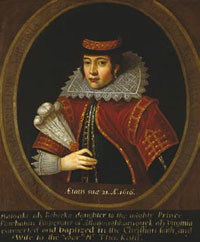国務省出版物
女性実力者の系譜-新世界への先導役「ポカホンタス」
 平和の象徴
平和の象徴
1595-96年頃生まれ、1617年死去
1595年頃、アメリカ・インディアンのアルゴンキン族に生まれたポカホンタスは、伝説の人となった。実際、彼女はアメリカへの初期の入植者たちの生活と自分の仲間たちに、平和をもたらそうと努力した女性である。
ポカホンタスは、現在のバージニア州に当たる地域に居住していたアルゴンキン族の有力な首長、パウハタンの娘だった。誰も確かめることはできないが、彼女が初めてヨーロッパ人入植者と出会ったのは、1607年春、ジョン・スミス船長がほかの入植者とともにジェームズタウンに上陸したときだったかもしれない。スミス自身が後に自分の人生の決定的瞬間について記述しているが、そのとき若きポカホンタスは重要な役割を果たしている。
スミス船長によると、彼はアルゴンキン族に捕らえられて命の危機に瀕した。若きポカホンタスは素早く前に進み出て、スミスと彼を処刑しようとする者の間に割って入り、スミスの命乞いをした。彼女の願いは聞き届けられ、友情が芽生えた。記述では、ポカホンタスは新たな入植者たちと親交を深め、時に食料を持ってきたり、父親からの伝言を取り次いだりした。
入植者とアルゴンキン族との間に緊張関係が生じたとき、サミュエル・アーゴールという英国人がポカホンタスを誘拐し、身代金を要求、条件に合意するまで人質にした。アルゴンキン族と入植者の関係が改善した後、ポカホンタスは英国人ジョン・ロルフと結婚した。時期は定かではないが、ポカホンタスは結婚までにキリスト教に改宗し、「レベッカ」という名前をもらった。アメリカ合衆国の未来にとって重要なのは、この結婚が、入植者とアルゴンキン族の緊張関係の緩和に役立ったことである。
1616年、ポカホンタスは、夫と幼い息子とともに船で英国へ向かったが、この旅は広く宣伝されることになった。ポカホンタスは国王ジェームズ1世と王室の人々に紹介された。彼女が最も感激した瞬間は、何年も前に死んだと思っていたスミス船長と再会したときだろう。悲劇的なことに、ポカホンタスは帰路、致命的な病に罹って1617年3月に亡くなり英国のグレーブゼンドに埋葬された。
ポカホンタスの生涯は短かったが、そのロマンチックな物語は米国人の想像力に訴え続け、多くの神話作りのテーマになった。それは、彼女の一生をもとにした数々の物語、本、絵画、さらには映画―最近では「ニュー・ワールド」―が作られ、また多くの町や校舎、さらには南北戦争の砦にまで彼女の名前が付けられていることに表れている。
*上記の日本語文書は参考のための仮翻訳で、正文は英文です。
Pocahontas - American women help the new nation - Women of Influence
(Born: c. 1595/6; Died: 1617)
Born around 1595 in the Algonquin tribe of American Indians, Pocahontas became the subject of legend. She was, in fact, a woman who sought to bring peace to the lives of the United States' first settlers and to her own people.
Pocahontas was the daughter of Powhatan, a powerful chief of the Algonquin tribe in the territory of present-day Virginia. Although nobody can be sure, she may have seen European settlers for the first time in the spring of 1607, when Captain John Smith landed with other settlers at Jamestown. Smith himself later would describe a decisive moment in his life during which the young Pocahontas would play a critical role.
According to Smith, he was captured by the Algonquin tribe and threatened with death. Rushing forward and placing herself between Smith and his would-be executioner, young Pocahontas pleaded for the captain's life. Her wish was granted and a friendship developed. Accounts say that Pocahontas went on to befriend the new settlers, bringing them food and delivering messages from her father from time to time.
As tensions arose between the settlers and the Algonquin tribe, an Englishman by the name of Samuel Argall kidnapped the young girl, holding her for ransom until he agreed to terms of settlement. After relations between the Algonquin and settlers had improved, Pocahontas was married to Englishman John Rolfe. Although the timing is unclear, Pocahontas had, by the time of her marriage, converted to Christianity under the name "Rebecca." Importantly for the future of the United States, the marriage helped to calm tensions between settlers and the Algonquin.
In 1616, she made a well-publicized journey to England by ship, along with her husband and their young son. Pocahontas was presented to King James I and to the royal family. Perhaps the most thrilling moment for her was meeting Captain Smith, whom she had believed dead for many years. Tragically, Pocahontas contracted a fatal disease on the trip home and died in March 1617. She was buried in Gravesend, England.
Despite her short life, Pocahontas's romantic story continued to appeal to the American imagination. It has become the subject of much myth-making, as witnessed by the many stories, books, paintings and even films – most recently The New World – based on her life, and the towns, school buildings, and even a Civil War fort named after her.




